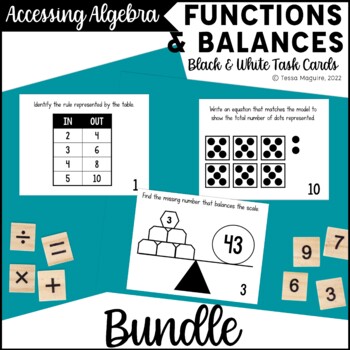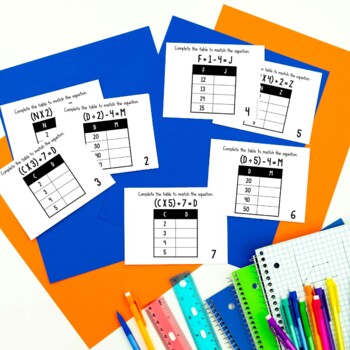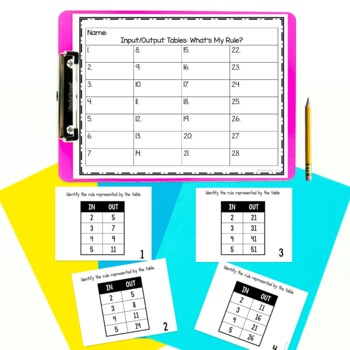Equations, Patterns, Input Output Function Tables, & Equality with Balances
- Zip
Products in this Bundle (8)
showing 1-5 of 8 products
Description
Accessing Algebra builds algebraic thinking through exploration of equations, function tables, patterns in numbers, and equality. Students write and apply one-step and two-step equations given models and data tables. By focusing on models and tables, these task cards feel like number and logic puzzles. They are a great way to build discussion and deep thinking around equations, variables, and equivalence. Students develop math reasoning and computation skills while applying number sense, logic, and algebraic thinking.
Accessing Algebra is designed to focus on applying algebraic thinking with our existing standards, giving students the tools they'll need for success later. By looking at the standards in a new way, students build a deeper understanding of the standard while also building their critical and algebraic thinking.
WHAT'S INCLUDED:
- Writing Two Step Equations to Models: Students use what they know about multiplication and addition to write two-step equations or expressions to match the given model.
- Multiplication Facts Balance the Equation: Students use skip counting or fact knowledge to identify the missing factor to make the balance equal.
- Two-Step Equations Balance the Equation: Students write the two step equation modeled on the balance and solve for the unknown.
- Multi Step Equations Balance the Equation: Students write the two equivalent expressions modeled on the balance and solve for the unknown.
- Mixed Operations Input/Output Tables: Students identify the rule or number pattern given on the input/output function table.
- Two Step Mixed Operations Input/Output Tables: Students identify the two step rule or equation that is demonstrated on the input/output function table.
- Applying One Step Rules in Input/Output Tables: Students apply a given rule or expression to complete the input/output function table.
- Applying Two Step Rules in Input/Output Tables: Students apply a given two-step rule or linear equation to complete the input/output function table. These include 2 variables: dependent and independent variables.
Each 28 task card set includes a recording sheet and answer key. These task cards are perfect for:
- whole class instruction
- small group instruction- both guided or independent
- fast finisher extensions
- high ability extensions
CLICK HERE to follow me and be notified of future products as soon as they are posted.
_______________________________________________________________
Copyright © Tessa Maguire.
Purchase is for single classroom use only. Please purchase additional licenses if you intend to share this product with colleagues.
You may not redistribute, edit, sell, or otherwise post this product on the internet. You may, however, post a link for others to purchase themselves.





